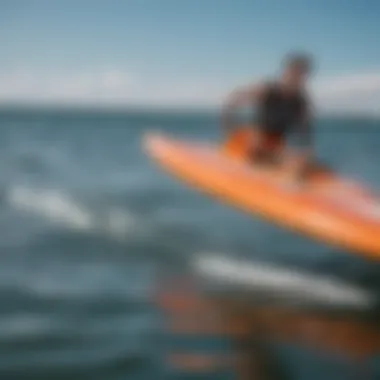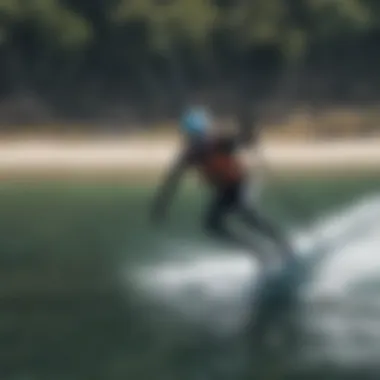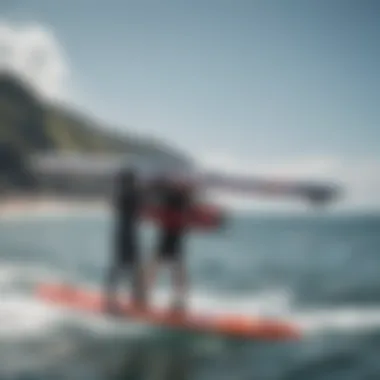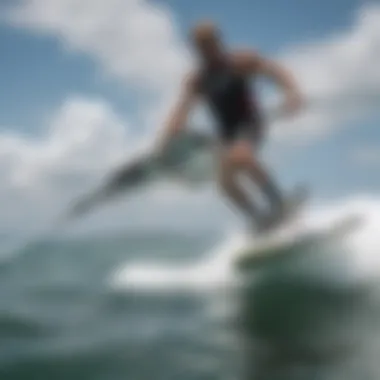Exploring Hydrofoil Components in Kiteboarding


Intro
As kiteboarding gains traction in the world of water sports, the use of hydrofoils has become increasingly popular. Hydrofoil systems elevate riders above the water, creating a new dimension of speed and maneuverability. But before you dive in, understanding the various components of these systems is crucial for both newbies and experienced enthusiasts alike.
This article aims to dissect the anatomy of hydrofoils, evaluating each part, from the front wing, rear wing, and mast to the fuselage and board. By acquainting yourself with these elements, you can make informed decisions when selecting your gear, enhancing your performance, and maintaining your equipment. Let's lace up and get into it.
Gear Selection
Selecting the right gear is key to maximizing your kiteboarding experience with hydrofoils. When it comes to hydrofoiling, not all kites and boards are created equal. The performance of the foil will largely depend on the type of kite and board you choose.
Types of Kites
The first decision revolves around the kites themselves. There are generally three main types of kites suitable for hydrofoiling:
- Leading Edge Inflatable (LEI) Kites
These kites are versatile and offer good lift, making them a popular choice among hydrofoilers. They inflate with air and provide a stable platform for your ride, particularly in lighter winds. - Foil Kites
Designed with efficiency in mind, foil kites are often used for hydrofoiling due to their ability to generate power even at lower wind speeds. They can be packed down smaller and are lightweight, making them easier to carry on adventures. - Hybrid Kites
As the name suggests, these kites combine elements from both LEI and foil kites. They offer versatility and cater to a range of riding conditions, making them friendly for both new and experienced riders.
When choosing a kite, consider the wind conditions in your area, your skill level, and what you aim to achieve on the water.
Choosing the Right Board
Just as selecting the right kite is essential, finding a suitable board is equally important. Hydrofoil boards come in various sizes and shapes, impacting your control and comfort:
- Length and Width: A longer board will provide more stability for beginners, while a shorter board offers agility for advanced riders.
- Volume: Boards with higher volume can float better, making it easier for beginners to paddle out, whereas lower volume boards tend to be faster but require more skill to maneuver.
- Material: Common materials for hydrofoil boards include fiberglass, carbon fiber, and wood. Each material has its pros and cons, so consider your budget and performance expectations.
Likewise, determining your board's performance characteristics can influence your ride experience. A well-chosen board elevates those hydrofoil sessions from mundane to dynamic.
The combination of an appropriate kite and board forms the cornerstone of a reliable hydrofoil setup, ensuring an enjoyable experience on the water.
This foundation lays the groundwork for effective skill development and progression.
Skill Development
Grasping the right techniques and skills will empower you to harness the full potential of hydrofoiling.
Essential Techniques
Beginner riders start by learning the basics of kite control and balancing on a hydrofoil. Essential techniques include:
- Learning to coordinate kite movements with your body weight
- Practicing transitions from the water into flight
- Mastering foot placements for better stability
As you progress, sustaining speed while turning and maintaining height above the water becomes crucial.
Progression Tips
Once comfortable, consider these progression tips:
- Practice, Practice, Practice: Regular time spent on the water will build your muscle memory and confidence.
- Watch Experienced Riders: Observing skilled kiteboarders can provide insights into tricks and techniques you might want to incorporate into your own riding.
- Join a Community: Connecting with fellow kiteboarders on platforms like reddit.com can foster learning and sharing of experiences.
Mastering hydrofoiling is a progressive journey, but by sharpening your skills and understanding your equipment, you'll undoubtedly enhance your kiteboarding adventures.
Prelude to Hydrofoiling
Hydrofoiling represents a thrilling leap in the kiteboarding experience, transforming how enthusiasts interact with the water. It allows riders to glide above the surface, reducing drag and enhancing speed. But what's behind this revolutionary sensation? The key lies in understanding the components that make up a hydrofoil system.
One might wonder about the benefits hydrofoiling brings to the table. Firstly, it elevates performance. Riders can navigate choppy waters with grace, enabling them to harness stronger winds efficiently. By rising above the water, they minimize resistance from waves. Secondly, the feel of hydrofoiling differs significantly from traditional kiteboarding. The experience becomes smoother, almost like floating on air, which attracts both seasoned kiteboarders and newcomers alike.
Considerations play a vital role as well. Not only does the rider’s weight and skill level affect gear choice, but understanding the hydrofoil's design can also shape their riding experience. From wing aspect ratios to fuselage lengths, each element contributes to performance and versatility. Choosing the right setup tailors the experience to the rider’s preference, whether they're focused on speed, maneuverability, or simply the thrill of cruising.
In summary, diving into hydrofoiling isn't just about purchasing the latest gear; it's about grasping the intricate relationship between components and performance. As we navigate through various parts of hydrofoil systems, the aim is to equip kiteboarders with the knowledge needed to enhance their hydrofoil experience, ensuring they make informed decisions that cater to their unique needs and riding styles.
"An informed rider is a confident rider."
By comprehensively understanding hydrofoiling, enthusiasts can elevate their time on the water, combining fun with informed choices.
Understanding Hydrofoil Systems
Navigating the waters of kiteboarding requires a grasp of the intricate systems at play, and nothing exemplifies this complexity quite like hydrofoils. Hydrofoil systems are not just a set of components strung together; they represent a cohesive unit designed to optimize performance and enhance the overall riding experience. Understanding these systems is crucial for both beginners finding their footing and seasoned kiteboarders chasing speed and agility on the water.
The significance of hydrofoil systems can be boiled down to a few core elements:


- Lift Generation: Hydrofoils work by creating lift as they move through the water. This allows riders to glide smoothly above the surface, significantly reducing drag and providing a unique sensation of flying.
- Stability and Control: A well-designed hydrofoil system contributes to stability and maneuverability, crucial for navigating various conditions whether the water is flat or choppy.
- Material Selection: The materials used in the construction of these systems—whether carbon fiber, aluminum, or composites—affect not just the weight but the responsiveness and durability of the hydrofoil.
- Adaptability: Many modern systems boast adjustable settings that enable riders to customize their setup based on skill level and riding style, making hydrofoiling inclusive and versatile.
Understanding hydrofoil systems also encourages kiteboarders to think critically about their gear. It’s not just about hopping on a board; it’s about engaging with technology designed for performance. Every component from the foil wing to the stabilizer contributes to achieving the right balance between speed, control, and comfort.
What is Hydrofoiling?
Hydrofoiling refers to the technique that involves mounting a specialized wing beneath a board which, when in forward motion, lifts the board above the water. This action reduces water resistance and enhances speed and efficiency. Picture it like this: you're skimming over the water’s surface effortlessly, enjoying a sensation akin to hovering. It’s a transformative way to engage with the elements, and the beauty lies in its simplicity juxtaposed with the complex engineering behind it.
In practical terms, hydrofoiling works on the principle of lift, much like an aircraft wing. As the hydrofoil moves through the water, it displaces water downwards, creating an upward force that lifts the board out of the water. This lift allows for smoother rides over choppy waters and the ability to move faster against the wind.
The Evolution of Hydrofoil Technology
The journey of hydrofoil technology is remarkable. Early versions emerged in the late 19th century, primarily in maritime applications, and kiteboarding didn’t take up the hydrofoil craze until relatively recently. The evolution has been marked by several key developments:
- Initial Designs: The first hydrofoils were heavy, bulky structures that required significant skill to operate. They weren’t very user-friendly, but they paved the way for subsequent innovations.
- Material Advancements: With the advent of lightweight materials, such as carbon fiber, manufacturers could enhance performance while reducing weight. This was a game-changer, as it made hydrofoils more accessible to a broader audience.
- Increased Customization: Modern designs often come with interchangeable parts that allow users to tweak their setup, from the mast height to various wing shapes. This means every rider can now have a tailored experience based on their unique preferences.
- Improved Safety Features: As technology progressed, so did safety measures. Features such as safety breakaway systems and better stability designs have made hydrofoiling not only more enjoyable but also safer for everyone involved.
As a whole, the evolution of hydrofoil technology signifies a fascinating marriage of art and engineering, aimed at elevating the kiteboarding experience to new heights. Each advancement showcases how a community’s desire for speed and agility drives innovation and pushes the boundaries of what’s possible on the water.
"Hydrofoils have transformed the performance landscape of kiteboarding, offering new thrills while demanding a deeper understanding of water dynamics."
Understanding these systems’ nuances and advancements is invaluable for anyone looking to get serious about kiteboarding with hydrofoils. It opens pathways to informed choices, enhancing the joy and performance on the water.
Core Hydrofoil Parts
When delving into the world of kiteboarding, the importance of hydrofoil parts cannot be overstated. The core components form the backbone of the hydrofoil system, each playing a vital role in how the rider interacts with the water. A proper understanding of these parts enhances both performance and safety on the water.
Foil Wing
Types of Wings
Various types of wings exist in the hydrofoil market, each with unique shapes and sizes to cater to different riding styles. For example, some riders opt for wide wings that provide more lift, making it easier to get up on the foil. These wings are particularly favored among beginners trying to master the feel of hydrofoiling. On the contrary, narrower wings are often preferred by advanced riders aiming for faster speeds and enhanced maneuverability.
The specific design—whether it's a high-aspect or low-aspect wing—dictates not only how efficient the wing will be but also how well it can perform during turns and transitions. A higher aspect ratio wing glides smoothly and requires less power to maintain speed, but it might sacrifice stability at slower speeds. So, the choice of wing type can dictate the kind of ride one can experience.
Wing Aspect Ratio
The aspect ratio of a wing is another critical factor in hydrofoiling. Essentially, this ratio is a measure of the wing's length compared to its width. A high aspect ratio means a long and slender wing, which often permits greater efficiency and speed but may be a challenge for balance. For beginners, a lower aspect ratio might simplify the learning process by offering more stability during takeoff and landing, while still allowing for decent performance once the rider becomes comfortable.
Understanding the implications of wing aspect ratio allows riders to optimize their setups for better performance based on skill levels and riding conditions.
Fuselage
Role of the Fuselage
The fuselage is the horizontal bar that connects the mast and wings together. This part is crucial as it directly influences the handling of the hydrofoil. A longer fuselage can provide better stability, yet this may come at the cost of responsiveness in tight maneuvers. Thus, finding the right balance based on one’s comfort level can be essential.
Riders looking for agility may prefer a shorter fuselage despite the loss of some stability. Conversely, those who enjoy cruising at high speeds might appreciate the steadiness offered by a longer fuselage.
Material Choices
Material choices for the fuselage range from aluminum to carbon fiber. Aluminum is typically sturdy and more cost-effective, making it a common choice for many riders. However, carbon fiber is lighter and offers superior strength, which translates to less drag and better performance in a race. The trade-off is, of course, the price; carbon fiber components often come with a heftier invoice. Therefore, material choice directly correlates with both performance expectations and budget considerations.
Mast
Mast Height Considerations
Choosing mast height is another vital factor for kiteboarders. A longer mast can allow for higher lifts, keeping the rider above rough waters, which is beneficial in choppy conditions. Nonetheless, this height can also make early learning stages tougher, as maintaining balance becomes trickier. For beginners, a shorter mast can facilitate a smoother learning curve, promoting confidence and stability when just getting the hang of hydrofoiling.
Riders who progress may find that they benefit from switching to taller masts as they adapt and wish to take full advantage of the hydrofoil's capabilities.
Material Properties
Material properties of the mast closely relate to weight and rigidity. Most masts are made from either aluminum or carbon fiber. Aluminum masts are very strong and reliable, but they can be heavier than their carbon counterparts. This trade-off can affect the overall dynamics of foiling, particularly in how responsive the setup feels. Opting for lighter materials allows for easier handling during jumps and tricks, which can be an attractive prospect for those looking to push their limits.
Stabilizer
Functionality of the Stabilizer
The stabilizer is often overlooked but serves as a key component in maintaining balance and control. This smaller wing attaches at the rear and helps to stabilize the foil system. Without an effective stabilizer, the risk of tail slides or unwanted deep dives significantly increases, especially during sharp turns. Thus, having a well-designed stabilizer contributes to a more enjoyable riding experience, as it promotes smoother navigation.


Different Designs
Stabilizers are available in a range of designs and sizes, affecting their effectiveness and rider preference. For example, a larger stabilizer can offer more lift but may create drag that limits speed. In contrast, a more streamlined stabilizer could help with speed but might not provide enough control for some riders. Understanding these dynamics allows for better customization of a hydrofoil setup based on personal riding style and conditions.
Accessory Components
Accessory components play a vital role in the overall functionality and performance of hydrofoil systems in kiteboarding. They not only enhance comfort and control but also add layers of customization to fit individual preferences. Understanding these parts become paramount for both newbies and seasoned users alike, as the right accessories can substantially improve the kiteboarding experience.
Board Interface
Attachment Mechanisms
The attachment mechanisms serve as the crucial link between the board and the hydrofoil. This specific aspect is essential because it dictates how effectively the foil can translate riders' movements into smooth water navigation. One key characteristic of attachment mechanisms, such as tracks and plate systems, is their direct influence on stability and maneuverability.
Tracks, for example, allow for a wide range of positioning, consequently aiding in balancing the center of gravity. This flexibility makes them a popular choice among kiteboarders who love to tweak their setups for either speed or stability. However, their unique feature of adjustability can sometimes lead to complexity during the installation process, especially for those who are not tech-savvy.
Adjustability Features
When talking about adjustability features, these are imperative as they allow riders to fine-tune the positioning of their foil. A notable characteristic of adjustable systems is how they accommodate various riding styles and conditions. Riders can shift the foil forward or backward, which can significantly influence the foil's lift and drag characteristics.
This personalization is a beneficial aspect of such systems. However, one downside could be that frequent adjustments, while enhancing performance, might require consistent retuning and checking, which could be cumbersome for some.
Foot Straps and Pads
Different Strap Types
Foot straps are crucial for keeping riders securely connected to their boards while riding, so various types of straps are available, each designed with specific needs in mind. The main characteristic of adjustable straps, for instance, is their ability to cater to different foot sizes and preferences. This adaptability makes them a widely accepted choice among enthusiasts.
Many riders prefer straps that are wider for added comfort and retention, especially during jumps. The downside is that some users might find the bulkiness of the straps a hinderance when they want to exit the board quickly in emergencies.
Ergonomic Considerations
The importance of ergonomic considerations cannot be overstated, as improperly fitted foot straps can cause discomfort or even injuries over time. The main characteristic here is the design of the footbeds and straps, which are often padded and contoured to enhance overall grip and comfort. This thoughtful arrangement is a key reason why many riders choose ergonomic designs.
Unique features such as shock absorption padding can significantly lessen the impact during hard landings. Still, riders should be cautious as overly cushioned setups can sometimes reduce the direct feel of the board beneath, possibly affecting agility.
Optional Add-ons
Safety Systems
Safety systems are essential add-ons that every kiteboarder should thoroughly consider. The primary aspect of these components is their function to enhance rider safety during more challenging conditions. Harness leashes that minimize the risk of entanglement and quick-release systems are notable examples. Their importance lies in how they can prevent accidents, making them a worthwhile investment for those who often push their limits in unpredictable waters.
One unique feature is the "quick-release" ability, which provides immediate detachment in emergency situations. However, relying on complex releases could sometimes add an extra layer of difficulty during standard rides, something to keep in mind for those less experienced.
Performance Enhancers
Performance enhancers are often seen as optional, but they can provide a significant boost to a rider's capabilities. Things like specific foil covers, custom fins, or even lightweight hardware play their part here. The key characteristic of these enhancements is their potential to improve speed or efficiency. Riders seeking maximum performance often gravitate towards them for that edge.
A noteworthy unique feature can be the use of dynamic shaping in fins, leading to better control and smoother rides. However, such fine-tuning may require an understanding of hydrodynamics that not all riders possess, which could be a barrier to some when considering upgrades.
Thus, effective understanding and management of accessory components in kiteboarding can either make or break the riding experience, emphasizing the necessity for kiteboarders to tailor their gear based on personal style and needs.
Performance Factors
Understanding performance factors in hydrofoil kiteboarding is crucial for riders who wish to optimize their experience on the water. The right combination of components and personal preferences set the stage for efficiency and enjoyment. Riders can better adapt to varying conditions, achieve their goals, and elevate their skills, propelling them to new heights—quite literally.
Choosing the Right Hydrofoil
Skill Level Consideration
When it comes to selecting a hydrofoil, skill level plays a vital role in guiding your decision. Beginners might benefit from foils that are more forgiving and offer a greater degree of stability. These types of foils are often wider and have larger wings, which help in maintaining lift even at slow speeds. This characteristic is especially advantageous for new riders still getting accustomed to the sensations of foiling.
A unique feature of beginner-friendly hydrofoils is their ability to provide a smoother ride, mitigating the risk of catastrophic falls. This can encourage confidence in new kiteboarders, allowing them to practice without the fear of frequent wipeouts.
Conversely, advanced riders may seek out specialized foils that allow for sharper turns and faster speeds. Choosing a hydrofoil suited to one’s skill level not only enhances the learning curve but also contributes to long-term satisfaction in the sport.
Riding Style Preference
Equally important is the recognition of riding style preference when selecting a hydrofoil. Each rider has a distinct style, whether it's aggressive carving, flat-water racing, or even freeride cruising. Understanding this personal inclination can greatly influence the hydrofoil choice. For those who enjoy fast speeds and want to skim across the surface, a smaller wing might be appropriate. This will yield less drag and faster acceleration but could compromise stability.


Alternatively, a rider focused on casual cruising or flat-water riding may find larger wings more appealing, as they offer increased lift and stability, making the ride leisurely and enjoyable. This feature allows for a more relaxed experience, which can be particularly appealing for those new to the sport or looking to ride for extended periods.
Impact of Materials on Performance
Any discussion of hydrofoil performance must address the materials used in their construction. The materials not only impact the overall durability but also influence how the hydrofoil behaves on the water.
Carbon Fiber vs. Aluminum
When comparing carbon fiber to aluminum, the former is often regarded as the premium option. Carbon fiber offers a superb strength-to-weight ratio, ensuring a lightweight build without sacrificing rigidity. This characteristic translates to enhanced responsiveness and efficiency during rides. Riders tend to find carbon fiber foils easier to maneuver, allowing for tighter turns and reduced drag.
On the flip side, aluminum is far more accessible and holds a sturdier build, making it less prone to damage. Its weight is greater, and that might hinder performance slightly, but it remains a solid choice for those who prioritize durability over speed. It is a favored option for riders who tend to push their equipment to the limits, yet it’s crucial to manage the balance between performance and durability.
Composite Options
Composite materials, which combine different materials to leverage their strengths, are gaining popularity in recent years. These hydrodynamic wonders offer enhanced performance while maintaining affordability. They can be tuned for specific ride characteristics, enabling manufacturers to create custom solutions suited for particular conditions.
The real game-changer with composites is the blend of properties; they can achieve both lightness akin to carbon fiber while offering decent durability found in aluminum. Due to their tailored nature, composite options can cater to a variety of riding needs, making them a versatile choice among kiteboarders.
"When you choose the right hydrofoil based on skill level, riding style, and material preference, you not only enhance your performance but also open doors to riding with greater confidence and ability."
In summary, understanding the performance factors associated with hydrofoil components not only boosts your skill level but also aligns your gear with your riding style. This informed approach is essential for achieving an enjoyable and satisfactory kiteboarding experience.
Maintenance of Hydrofoil Parts
Maintaining hydrofoil parts is a crucial aspect of kiteboarding that often doesn't get the spotlight it requires. Proper upkeep can significantly enhance performance, prolong the lifespan of your equipment, and, let’s face it, avoid mid-session mishaps that can be both frustrating and costly. When your hydrofoil setup is in top-notch condition, you're more likely to have a smoother ride, allowing you to focus on enjoying the waves instead of worrying about repairs.
Routine Inspection
Routine inspections are your first line of defense against wear and tear. Regularly examining your hydrofoil setup can help catch potential issues before they become serious.
Checking for Wear and Tear
Going through the nitty-gritty of checking for wear and tear is essential. This involves inspecting the foil wing edges, mast connection points, and the fuselage for any signs of degradation or damage. The key characteristic of this task is its proactive nature. By identifying mundane cracks or corrosion early, you can avoid significant performance hits or even catastrophic failures on the water. Catching these issues before they escalate allows you to maintain peak performance.
"An ounce of prevention is worth a pound of cure," the age-old saying rings especially true when it comes to hydrofoil maintenance. Paying attention to even minor issues can save significant time and money later.
One unique feature of this practice is that it promotes not only performance longevity but also rider safety. If a part fails during a ride, it can lead to accidents, making this inspection a beneficial choice for kiteboarders.
Identifying Damage
Identifying damage goes hand in hand with wear and tear checks. Whether it's a dent in the wing or a loose screw in the fuselage, recognizing these red flags early can prevent more extensive damages. This process involves visually inspecting each component and occasionally performing some physical checks. The key characteristic here is thoroughness.
This is absolutely a beneficial practice as it allows for quick repairs, ensuring that your setup is always in competition-ready shape. A damaged part might not just compromise your ride; it can trigger problems that affect other components, too. Therefore, taking the time to inspect each part thoroughly is not just wise but essential for maintaining the overall performance of your hydrofoil system.
Cleaning and Storage
Beyond routine inspections, proper cleaning and storage practices play an indispensable role in the longevity of hydrofoil parts.
Recommended Cleaning Techniques
When it comes to cleaning, using fresh water to rinse off salt and sand after each use is highly advised. This acts as a barrier against corrosion and degradation over time. The unique feature of this technique lies in its simplicity and effectiveness. Just a little time spent rinsing can lead to significant improvements in the condition of your equipment. In this article, it's highlighted as a popular and practical approach because it doesn't require special tools or chemicals — plain water does the trick.
However, be cautious not to use abrasive materials or harsh cleaners, as they might scratch or dull the surfaces of your hydrofoil setup. Gentle sponges and mild soap are your best pals in this endeavor.
Optimal Storage Practices
How you store your hydrofoil is just as essential as how you clean it. Keeping your hydrofoil out of direct sunlight, in a cool dry area, can prevent warping and fading. The key characteristic here is offering protection from environmental factors.
To ensure optimal performance next time you take to the water, consider using padded bags and covers designed specifically for hydrofoils. A unique advantage of this practice is that it can save you from potential structural damages and keep your equipment looking fresh. However, proper storage does require a dedicated space, which might not always be feasible for everyone.
In summary, the maintenance of hydrofoil parts encapsulates a range of practices focused on routine inspections, damage identification, cleaning, and storage. Adhering to these guidelines not only ensures performance but also extends the lifespan of crucial components in your kiteboarding experience.
Closure
In wrapping up our exploration of hydrofoil systems in kiteboarding, it becomes clear that understanding these parts is not merely about knowing what they are but also about appreciating how they come together to enhance your overall riding experience. The function of each component—from the foil wing that defines your lift to the fuselage which connects everything—plays a crucial role in not just performance but also in safety and enjoyment while out on the water.
Key Considerations:
- Component Integration: Each part integrates into a cohesive unit that significantly impacts performance. How well these pieces connect can determine your ability to maneuver efficiently and respond to changing conditions.
- Performance Optimization: Knowledge of what each piece does allows you to make informed decisions when selecting your hydrofoil. Are you riding freestyle? Then a specific stabilizer shape might benefit you best, while a different mast height could be preferable for speed enthusiasts.
- Maintenance Importance: Regular care and inspection of these components not only prolongs their life but also ensures you’re riding with confidence. Neglecting even the smallest connection or wearing part can lead to issues that disrupt your entire session.
Moreover, understanding hydrofoil parts aids in creating a more tailored kiting experience. Whether you’re a seasoned rider or a newcomer, knowing the ins and outs allows for a personalized setup that can adapt as your skills and style evolve.
As kiteboarding continues to evolve, staying informed about hydrofoil technology not only enhances your performance but also enriches your engagement with the sport as a whole. In the words of experienced riders, "The more you know, the more fun you can have out there!"
So whether you’re fine-tuning your gear for an exhilarating ride or simply enjoying a windy day on the water, the insights garnered from understanding hydrofoil parts will always come in handy.















